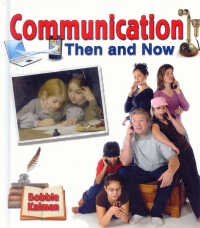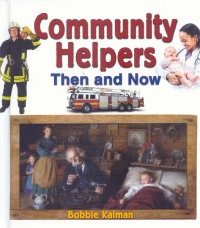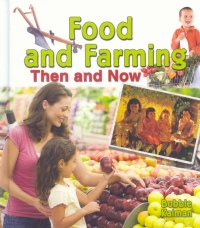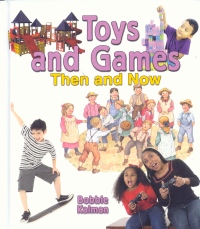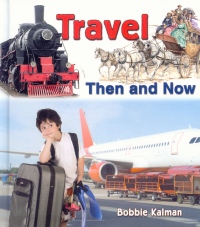| ________________
CM . . .
. Volume XX Number 32. . . .April 18, 2014
excerpt:
Six titles comprise the new “From Olden Days to Modern Ways in Your Community” series by Crabtree. Though the publisher states that the series “takes readers on a journey back to the early 1900s”, there is no explanation of this by way of an introduction in any of the books, and, in fact, some of the information in the books goes back even further, to the mid-1800s. With only 24 pages of text (including the table of contents, glossary, index and the list of books and web sites for further study), the subject matter is very general and rather glossed over. What is evident, in many cases, is the omission of some important facts. For example, in the title about communication, there is no mention of news being reported on the radio, nor is there mention of the radio having been an important source of entertainment years ago, a time when families would gather around the radio after supper to listen to stories and plays. The text is written in a large, simple font, and there is plenty of white space around it. To make the text slightly more “interactive”, Kalman poses questions to her readers, but even some of these questions are rather insipid, and others, unless readers live in a community which has some of the features mentioned in the text, are unanswerable without further research. For instance, in the title about travel, Kalman asks, “How is this streetcar different from a streetcar today?” If the reader lives in a community where there are no streetcars, how can he or she answer the question? There are also a few instances where the author gets sidetracked and goes slightly off topic. Illustrations consist of black and white and colour photographs as well as coloured drawings. Several of them are repeated in different titles in the series. Communication Then and Now highlights body language and facial expressions, communicating through social media, telephones, snail mail and email, storytelling, publishing (though magazines have been omitted from the examples), television, and communicating culture via movies, music, food, clothing, dance and art. Though this title includes photos of the most recent technology, it might soon become outdated as technology’s ever-increasing pace will make some current communication methods obsolete in a short time. In Community Helpers Then and Now, readers will be introduced to workers in various walks of life, from medical personnel, police officers, firefighters, and construction and tradespeople to school helpers and food and farm workers. A couple of flaws in this title include the omission of secretaries, custodial staff and specialist teachers (such as gym, music and resource teachers) from the chapter on school helpers, and the inclusion of a photograph of a group of people dressed in their work clothes. The reader is asked to name the community helpers in the photograph, but five of the nine people in the photo are dressed in dark suits and two of them have briefcases. Perhaps the point that Kalman wanted to make was that several occupations require business attire, but this concept will likely be lost on the target audience. Of all the titles in the series, Food and Farming Then and Now is slightly better than the others in that it promotes whole foods, healthy eating, foods made without preservatives, and the concept of eating locally to save on fuel and to help the environment. In this title, readers will learn where their food comes from, with specific examples such as honey, maple syrup, meat, grain products, and fruits and vegetables. Kitchen appliances and methods of cooking and keeping food fresh are also highlighted. School Days Then and Now focuses on the contrast between the one-room schoolhouses of the past, with one teacher, multi-age levels of students, and learning by recitation and writing on slates, and modern schools, with specialist teachers, single-grade classes and computer labs. Other topics covered in this title include recess activities, learning tools and educational games. Children long ago had little leisure time because they had to help their parents on the farm or around the house. But, despite the lack of time and having no video games or a lot of toys, kids still managed to have fun and participate in games and some sports. Toys and Games Then and Now features popular toys, board games, word, number and classroom games, outdoor fun, sports, and fun on wheels such as scooters, bikes, skateboards and in-line skates. Party and parlor games, such as bobbing for apples on Hallowe’en, are also mentioned. Finally, Travel Then and Now show readers various modes of transportation on land, water, and in the air. In the past, people relied on animals to transport heavy loads, work on the farm, and carry people, goods and mail from place to place. Steamships, motorized wagons and steam-powered trains were considered de rigueur. Nowadays, however, people travel quickly by car, subway, commuter train and airplane, and passenger travel by ship tends to be solely for vacation purposes. Helicopters and snowmobiles can be used for recreation as well as for emergencies in remote areas. A very basic series with lots of pertinent information missing. Communication Then and Now - Not Recommended. Gail Hamilton, a former teacher-librarian, lives in Winnipeg, MB.
To comment
on this title or this review, send mail to cm@umanitoba.ca.
Copyright © the Manitoba Library Association. Reproduction for personal
use is permitted only if this copyright notice is maintained. Any
other reproduction is prohibited without permission.
NEXT REVIEW |
TABLE OF CONTENTS FOR THIS ISSUE
- April 18, 2014.
AUTHORS |
TITLES |
MEDIA REVIEWS |
PROFILES |
BACK ISSUES |
SEARCH |
CMARCHIVE |
HOME |
